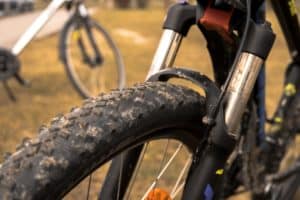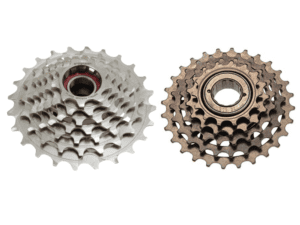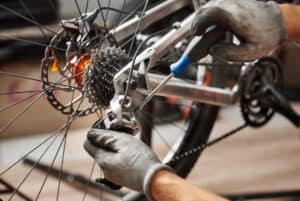Want to know how fat bikes and mountain bikes differ? Then you are in the right place. We go in-depth into fat bikes vs mountain bikes so you know which one best suits your needs and budgets.
Fat Bikes
The reason people love fat bikes is that they are built to fit both daily commutes and off-road trails. These hybrid bikes are uniquely built to provide an ultimate and fun riding experience for adventure rides as they can be ridden in deep snow, rough terrains, and even loose sand.
The highly inflated tires are both cool and strong as they give these bikes their unique functionalities hence the name “fat bikes”. The tires are larger than those found in other bikes as typical fat bikes would measure 700c x 47mm on the front wheel and 650b x 48mm on the rear wheels. The bike frame and fork are designed to hold the large tires comfortably.
Also, the wide tires help distribute the rider’s weight evenly over a larger surface area which allows better traction and reduces the ground pressure.
The tires are also soft so the bike can be easier to ride on wet terrains, in the mud, and when descending a hill so the wheels do not slip and give way. Fat bikes also make gliding through terrains with obstacles like ice, stones, bumps, and holes easier as they make riding smoother.
Pros of Fat tire bikes
Excellent traction
The wide tires allow fat tire bikes to have a larger surface area on the ground thereby allowing a better balance. The low-pressure tires also give the bike an advantage by making them softer to glide over any surface.
With this, you can ride in sand, snow, and mud easily without sinking or losing balance as the tires will just roll over these terrains and float over them. This makes them a perfect choice for dessert dwellers as well as those staying in colder climes.
All-year-round rides
The most durable of fat bikes are well suited for weather conditions whether snowy, rainy, or drier conditions. With this, you can ride for 12 months easily and safely as they can handle these terrains properly.
Multi-functionality
Fat tire rims are built to allow mountain bike tires to be fitted into them so you can easily upgrade your bike into a mountain bike.
Shock absorber
With a shock absorber on both the front and rear wheels, you deal with broken spokes and cracked rims less often as the high volume wide tires take the impact of bumps and drop off the overall bike frame.
The rims are also stronger as the materials are durable and thick so more gear and weight can be carried for long hours without causing damage to the wheels.
Due to the smaller diameter rims used by the bike, they can only fit shorter spokes which are stronger than their larger counterparts so they break less often. The rims also do not get cracked or warped easily.
Fat Bikes are great for exercises
Due to their wider tires, fat tire bikes are usually heavier so they take more strength and energy to ride and attain a good speed. The energy is usually more than that required for mountain bikes so you can blast up to 1000 calories per hour riding a fat tire bike.
This is great for those looking to lose weight and stay fit as the extra effort taken to get the bike rolling can help enhance both stamina and strength.
Fat tire bikes are beginner-friendly
These bikes are easy to ride and maneuvering around obstacles is easy so beginners can easily start cycling with fat-tire bikes. The shock absorber fitted in the front and rear wheels also make impacts on rocks and other obstacles less felt like the bike balances after riding over them.
It is also stable and offers excellent traction that gives a beginner more confidence in their riding skills. The wide handlebars also offer loads of grip so a beginner can hold on to the bike tightly without losing traction and also give them a sense of safety.
Fat bikes are safe
As mentioned earlier, fat bikes are heavy and require more energy to ride so their speed is usually low thereby keeping the rider safe and giving them enough room to maneuver out of harm’s way. Falls from fat-tire bikes are usually less injurious as you are not riding too fast.
Cons of Fat tire bikes
Fat tire bikes are less efficient
Due to the low pressure of the tires and the larger surface area, there is more contact with the ground which makes friction higher. This causes low speed and higher energy expenditure.
There is also more air resistance from the wide tires so the rider has to put in more energy to keep the bike going at a consistent speed.
The bulkier weight of the bike also adds to this problem thereby making fat-tire bikes less energy efficient. Therefore, you have to pedal at a faster rate to maintain speed which makes you tired easily. With this, you can only cover a short distance unless you are riding off-road.
Fat tire bikes are heavy
Most standard fat-tire bikes weigh between 33 to 40 pounds with the lightest models being about 30 pounds. This is due to the wider tires and rims which need more materials. All these contribute to the lesser efficiency of the bike.
Fat tire bike parts are not easy to find
Due to the size of the frame and tires, replacement parts for these bikes are difficult to find as most shops don’t stock them because the sizes are non-standard.
So in case you break a spoke or get a damaged tire while riding along the countryside or remote areas, you are less likely to get replacement parts until you get to the capital city or might even have to order from the manufacturer online.
Fat tire bikes are slow and less maneuverable
The tires need extra effort to keep them going so you cannot accelerate faster to gain speed. Navigating through technical terrains is difficult as the tires and wheels slow down the steering.
Mountain Bikes: Main Differences
Mountain bikes are one of the most loved bike variations that have been around for quite some time and are popular among off-road riders.
They are highly durable and perfectly suited for all forms of terrains ranging from irregular and bumpy to the countryside and off-road. They are built to adapt to harsh conditions and terrains while making your adventure ride exciting. The off-road components integrated into the bike’s build make it heavy.
The suspension fork makes the ride smoother as the front and rear wheels are fitted with shock absorbers for reducing the impact of obstacles on the tires thereby making rides on rough terrains and downhill faster.
They also come with large knobby tires fitted with large wheels. Typically, they come with wheels ranging from 24 inches to 29 inches while the tires could be tubed or tubeless.
Newer mountain bike designs use disc brakes with incredible stopping power in all conditions and terrains while the gears are usually of lower-gear ratios for navigating through hilly terrains.
The handlebars are wider than found in other bikes to provide an excellent and extra grip for more balance and comfort. These features make mountain bikes excellent for climbing and ascending mountains and also gliding through forest tracks and curvy routes.
Pros of Mountain bikes
Mountain bikes are more efficient
They are lightweight and the tires are narrow with higher pressure in them so they do have a lot of friction with the ground and there is lesser rolling resistance.
Air resistance is also lesser so you can ride at full speed without expending a lot of energy. Even when you stop pedaling the bike, it keeps going at optimum speed. You can also attain a higher speed faster with mountain bikes.
Lighter and easily maneuverable
The tires and rims used by mountain bikes are lighter and narrower so most mountain bikes weigh about 5 to 10 pounds less than fat-tire bikes.
This makes them faster as they do not require a lot of energy to get them up to maximum speed. They are also easy to handle so you can maneuver around corners and obstacles easily as the steering is more responsive.
Versatile and great for learning technical riding
Mountain bikes can be adapted to any type of riding or terrain whether touring, off-road rides, mountain climbing, and several others so if you are short of funds and need a bike that can do it all, they are your go-to option.
You also learn how to maneuver around obstacles, balance, and climb technical and rough terrains with mountain bikes. You can drop or lift a wheel over obstacles and these functionalities help you gain more skills for tougher terrains or even professional cycling.
Cons of Mountain bikes
Less traction
Although their traction is also excellent, the tires do not have a lot of surface area to handle terrains fat bike tires would easily tread. Mountain bikes do not have a lot of contact area with the ground thereby making hits have higher impacts on the bike parts.
Not suited for all terrains
Certain terrains like sand, mud, snow or slippery grounds do not resonate well with mountain bikes as they suck in the tires and cause them to sink. These terrains do not allow you to pedal and could even cause the bike to slip from your grip.
Lower shock-absorbing abilities
Mountain bikes do not absorb shock as much as fat tire bikes due to their higher air pressure and lower volumes which make the shock from bumpy rides seep into your body. However, a bit of the shock can be absorbed by the rear wheels but this cannot be compared to fat-tire bikes with dual suspension.
More wheel damage
With larger wheels, mountain bikes can only accommodate longer spokes which are usually weak so they break easily. The rims are also structurally weaker so they tend to crack when stressed. This makes cracked or warped rims and broken spokes a common problem found in mountain bikes.
Do not allow all-year-round rides in colder climes
If you stay in a snowy climate, you might have to pack up your mountain bike for the snowy months as they are not built for this type of terrain. Although you can walk around this by installing studded snow tires to give you more grip when riding through snow and ice.
Fat Bikes vs. Mountain Bikes
With both bike variations discussed alongside their pros and cons, it is safe to conclude that they are both great bike options with distinct features. Some of the differences between both bikes are outlined below.
Difference in tire sizes
Both fat-tire bikes and mountain bikes come with tires that are different from other bike types. However, the major difference between both variations is the size of their tires.
Mountain bikes come with large, knobby tires while fat-tire bikes have smaller but wider tires. Standard fat-tire bikes measure between 3.8 inches to 5.2 inches as compared to typical mountain bike tires which measure between 1.9 inches to 2.6 inches in width.
Also, fat tire bike rims measure between 55mmto 65mm while those found in mountain bikes are only about 30mm wide. Wheels found in fat tire bikes are either 26 inches or 27.5 inches in diameter while mountain bike wheels are usually about 29 inches in diameter.
There is also a significant difference in the amount of pressure the tires found in each bike run at. Mountain bike tires run at a higher pressure of between 22 to 25 psi while fat bike tires run at a lower pressure of between 5 to 14 psi due to the wider tires.
The large, knobby tires possessed by mountain bikes allow them to have a firm and excellent grip on rough terrains which keeps the ride balanced especially when climbing steep hills and riding at high speeds.
On the other hand, the smaller, wider ones found on fat-tire bikes are soft which makes riding on wetter terrains and mud easier with lesser support. They also make gliding with the bike possible when compared with other bikes.
Difference in bike frames
Mountain bike frames are designed for off-road trails and rough terrains so their performance and handling are strong and of superior quality.
Also, they are lighter in weight when compared with fat tire bikes as a result of their frame placed lower and the wheels being smaller which makes riding through loose terrains easier.
On the other hand, fat tire bikes are heavier due to the wider tires and this tends to slow them down as they might not roll faster in rough terrains.
Additionally, fat tires do not have any clearance beneath the frame thereby they can roll over anything while riding and this could cause injury or even death if the bike falls on the rider.
Most designs now come with wider fork arms, chainstays, and seat stays to provide more space for the hubs and ensure the wide tires don’t rub. However, with the knobby and treaded tires on mountain bikes, there is clearance so they can ride through terrains with obstacles without running against them.
Difference in clearance
Due to its build and frame, mountain bikes only have clearance for slimmer tires which tends to slow the rider down. However, fat-tire bikes have more clearance for larger and low-pressure tires which helps them maintain a solid grip on sandy and most terrains.
The frame also allows them to carry more weight for adventure rides so you can pack whatever you want. On the other hand, mountain bikes have a shorter frame which makes long-distance riding uncomfortable.
Difference in functionality
If you are looking for a bike that can do it all, mountain bikes are a better option as they can close through any terrain and they are also lighter. Fat tire bikes on the other hand are not great options for steeper and hilly terrains due to their size and weight.
They are better suited for snowy, muddy, wet, and off-road riding which makes them great for cross-country tours as you can even pack more gear with the larger frame.
Difference in customization options
If you love customizing and upgrading your bike, then mountain bikes are a better option as they are built to allow changes in their design and part.
They can also be tweaked to attain better performance with parts added for extra functionalities. However, with fat-tire bikes, you do not have a lot of customization and upgrading options.
Conclusion
Mountain bikes are suited for most terrain types except in snowy, sandy, and mud terrains and they also come with higher energy efficiency. Fat tire bikes are also great for off-road trails with the tires allowing them to traverse where other bikes can’t.
The choice is up to you but if you are on a budget, mountain bikes could be an option as they cost less than fat-tire bikes and you can get an all-in-one bike.
However, your riding trails, personal preference, and climate should all be considered when considering whether to go with fat bikes vs mountain bikes.





